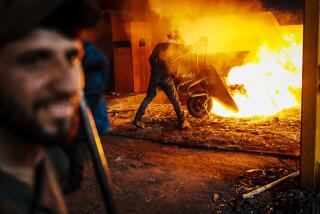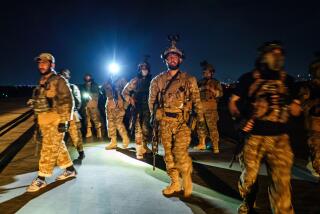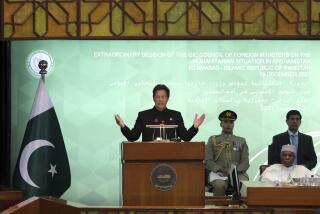The ‘Af-Pak’ problem
- Share via
Just in case he had any doubts about the challenges ahead, U.S. envoy Richard C. Holbrooke was welcomed to South Asia last week with a bomb in the Pakistani border city of Peshawar and coordinated attacks in the Afghan capital of Kabul that left 26 dead. Afghanistan’s intelligence chief said there may have been contacts between the assailants in Kabul and militants in Pakistan, underscoring that the neighboring countries represent two fronts in one war. The Obama administration has recognized this with Holbrooke’s portfolio, which is now being called “Af-Pak.”
Holbrooke is there to review U.S. policy on Afghanistan and Pakistan; findings will be delivered to a NATO summit in April, when allies undoubtedly will be asked to contribute more troops and aid for the fumbled war effort. The full extent of that failure has become clearer with new assessments of Taliban gains in the last two years through guerrilla hit-and-run strikes, roadside bombs and suicide attacks. Director of National Intelligence Dennis C. Blair said last week that support for the Taliban has grown in response to the corruption and ineffectiveness of the U.S.-backed government of Afghan President Hamid Karzai.
Where do we go from here? Defense Secretary Robert M. Gates has asked for an Iraq-style “surge” of about 30,000 troops in Afghanistan to beat back Taliban gains and step up training of the Afghan army and police. President Obama rightly asked him to define the mission and endgame before authorizing the full deployment. Exactly what are the military objectives? Are we there for years or decades? Are we trying to stabilize the country or build democracy?
As with most wars, there is no purely military solution to this one. Army Gen. David H. Petraeus, the architect of the surge in Iraq, argues that troops must be accompanied by economic and reconstruction aid to help strengthen the central government. That would be true if the Afghan government were competent and the international community held it accountable for the aid it receives.
Just as important, however, is the “carrot-and-stick” diplomatic work needed to convince Pakistan’s government and, more important, its military that it is in their strategic interest to eliminate insurgent strongholds on the border. Currently, the Pakistani military views the insurgents as means to counter the undue influence in Afghanistan of its nemesis, India, and the U.S. The Taliban insurgency cannot survive without Pakistani aid and sanctuary.
Karzai has long argued for dialogue with moderate elements in the Taliban, but his requests for their safe passage to talks were denied by the Bush administration, which viewed Islamic extremists in monolithic terms. That was a mistake. It is essential to bring nationalistic factions of the Taliban into the political process. For that to succeed, however, the Obama administration will need what the Taliban now enjoys -- support from its patrons in Pakistan.
More to Read
Sign up for Essential California
The most important California stories and recommendations in your inbox every morning.
You may occasionally receive promotional content from the Los Angeles Times.








